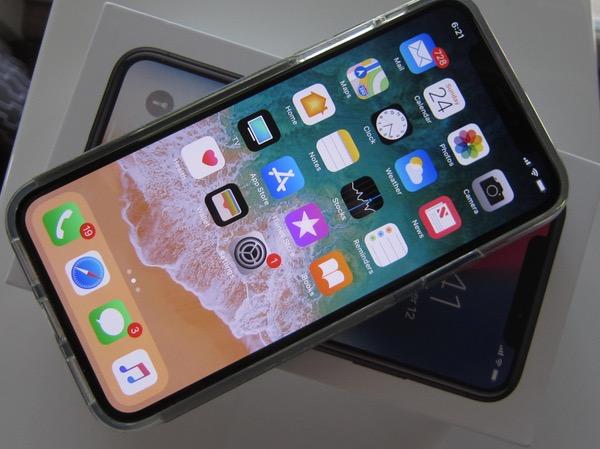Phones and Groans

But my recent experience with a new smartphone offers cautionary lessons also applicable to our more house-bound entertainment goodies: televisions, AVRs, speakers, home assistants, home automation, and more.
But my recent experience with a new smartphone offers cautionary lessons also applicable to our more house-bound entertainment goodies: televisions, AVRs, speakers, home assistants, home automation, and more.
Occasionally I’ll have to download an app to use with a product under review. That need triggered my recent replacement of an ancient iPhone 4s. I chose a new iPhone X. The latter has come in for its share of criticism, but for me it was like stepping from the 19th century into the 21st. Until, that is, six weeks in when its screen went totally dark.
I tried all of the usual cures, available on more web sites than you can count (apparently this isn’t an isolated issue). Push this button, then that button, then hold a third button until the Apple logo appears or it’s time for dinner. Nothing helped. The phone was clearly still on; when I called my smartphone number it rang, and some random poking around on the blank screen turned on the built-in flashlight. But while I could now see in the dark, the phone’s OLED screen remained midnight black.
Fortunately the Verizon store where I bought the phone was just a few minutes away. The attendant there tried all of the things I had already attempted, then gave up and advised that I contact Apple. That’s when I discovered that if replacement was needed I’d have to go to a Verizon owned store. It appears that there are Verizon stores and then there are Verizon stores. Some are company owned, but many are independent franchises. The latter give off the warm fuzzies by flying the Verizon banner, but are actually locally owned and run. My local store is the latter. It can sell phones and set up accounts, but can’t do even minor repairs or exchanges.
When I got home I called Apple. They went through the same song and dance checks with no result, then recommended that I go to an Apple Store. I replied that my nearest Apple Store is 250 miles away, a 4 hour drive. After a pregnant pause (the rep must have been gob-smacked in hearing that anyone could survive that far from an Apple Store), he recommended the Geek Squad at Best Buy as an alternative. He then gave me the name of the closest Best Buy from Apple’s list. It was 60 miles away. I was puzzled at this, as there’s another Best Buy about 30 minutes from me. I later learned that while all Best Buys sell Apple products, not all Best Buy Geek Squads are on Apple’s approved list for in-store helpwhich made me wonder why not. Perhaps Apple tech supporters have to go through some sort of Apple Boot Camp, complete with drill sergeants and PT, and the rep that the local Geek Squad sent had washed out.
This was now getting out of hand, so I decided to try the nearest Verizon-owned store, this one also about 30-minutes away. After they tried the same solutions that everyone else had they gave me (hooray!) an authorization for a replacement, which would be shipped from iPhone Central and delivered to me the next day! They didn’t take my broken phone, and didn’t explain why. It turned out it that the replacement phone’s shipping box included return instructions plus a pre-paid shipping label. Good thing I hadn’t tossed the old one off the bridge and into the bay on my drive home; there’s a $500 penalty for not returning it.
That doesn’t quite end the tale. Since I don’t currently reside on the iCloud, I went back to my local (franchise) Verizon store hoping they could once again transfer the data from my old iPhone 4S onto the new iPhone X (they had done so when I bought the first X). Fortunately, in my short time with that first iPhone X I had only added a few things to it, so restoring the data from the 4S would have been sufficient.
But it turned out I had long ago forgotten the password for my e-mail and didn’t know how to reset it. Re-setting that password sent me on another 30 minute pilgrimage to my local e-mail provider. The re-set turned out to be easier than I expected. But changing your e-mail password on one device means that if you aren’t connected to the iCloud all of the other devices you use for e-mail (I had three) would each require a manual password change as well. Fortunately I now knew how to do that. Finally, after taking big chunks out of three days, my replacement iPhone X is now up and running.
A Few Cautionary Notes
1. When you buy anything, check the credentials of the store (or Internet site) you buy from. How knowledgeable are they? Can they repair the device, or if not at least exchange it for a new one?
2. Are there alternate sources you can go to for advice, both reliable and reasonably close, if your first attempt at solving a problem fails? A smartphone is easy to carry around when seeking help (even if that help might come only after some time-consuming, wrong turns!). But what about that 65-inch flat screen TV, that retractable screen you’ve screwed onto your wall or ceiling, or a pair of heavy speakers (or an 80 pound subwoofer)?
3. While help for almost anything is a mere a Google search away, it isn’t always useful or even accurate. The instructions I found for changing the e-mail password on my iPad were either out of date or my iPad (roughly 2 years old) was itself behind the times.
4. If the product you buy costs more than you can afford to lose, avoid buying from companies that haven’t been in business for at least a couple of yearsunless they’re a spin-off from a long-established firm that will stand behind the purchase. While this advice may be unfair to startups that might turn out to be the next Sony or Pioneer, launching a new company is always risky.
5. Most electronic gizmos are remarkably reliable today, but there’s still a finite failure rate for everything, no matter how well built. Don’t immediately toss the box that your new toy came in. Keep it as long as you can, or for at least 90 days. If a product is going to fail in its first three years it’s most likely to do so within its first 3 months. And warranties sometimes require that the product be returned with its original shipping material. I still have the shipping box for my 2009, 65-inch Pioneer Kuro plasma HDTV. Actually, it’s been in that box since I moved to Florida 3 years ago!




























































